Energy utilization of Broiler chickens on vegetal protein diet
Energy Utilization and Growth Responses of Broiler Chickens on Vegetable Protein Diets
Published: May 28, 2012
By: Mohammad A. Hossain, A.F. Islam and Assoc. Prof. Paul Iji (University of New England)
SUMMARY
This study was undertaken to investigate the gross response and energy utilization of broiler chicks fed on vegetable protein or conventional diets. Two hundred and fifty-two day-old Cobb-500 male broiler chicks were randomly assigned to five experimental groups and raised on a control diet (containing tallow) or diets containing fish meal (SBM50 and Can50) or diets with no animal products (SBM75; Can75) (predominantly soybean or canola meal). Birds were reared mainly on litter under similar environmental and management conditions from 1 to 21 days on starter diets. Feed intake was highest (P<0.001) on the SBM50 and Can50 diets, and lowest on the SBM75 diet. Birds in the SBM50 and Can50 diet groups were heavier (P<0.001) than those in other groups, with SBM75 and Can75 diet groups being the lightest. Birds on SBM75 and Can50 achieved superior feed conversion ratio (FCR), while birds on Can75 diet were the poorest. The dietary apparent metabolisable energy (AME) contents were similar, but ME intake on the SBM50 and Can50 diets was higher (P<0.001) than in other groups. Heat production (HP) was similar, but net energy of production (NEp) was improved (P<0.05) in the birds on SBM50 and Can50. Birds on SBM50, Can50 and Control diet groups retained higher (P<0.05) energy as fat (REf), while energy retention as protein (REp) was highest (P<0.05) in the SBM50 and Can50 diet groups. The efficiencies of utilization of ME for energy (KRE), protein (KREp) and fat (KREf) retentions were unaffected. The results demonstrated that birds on the conventional diets (SBM50; Can50) utilized energy better, and grew faster than the birds on vegetable protein (SBM75; Can75) and Control diets.
I. INTRODUCTION
Feed costs represent a major cost in poultry production (about 70%), with energy sources occupying the greatest portion (70 to 75% of the diets) (Van der Klis et al., 2010). Birds are prone to feed mainly to satisfy their energy requirement and, once this is met, they will not consume any more feed even if the requirements for other nutrients like protein, vitamins or minerals have not been met (Sing and Panda, 1992). For this reason, the energy content of the diet represents a central theme in diet formulation for poultry. The performance of birds is closely associated with feed nutrient and energy utilization, which is primarily related to availability of more nutrients and energy from the feed ingredients (Olukosi et al., 2008).
Most of the dietary energy comes from plant sources in the form of carbohydrates from cereal grains. Around the world, soybean is the premier vegetable source of protein while canola seed meal is also gaining in popularity. Animal protein sources are usually more balanced in amino acids than vegetable protein sources but there is a wide variation in the material that is used around the world. Processed meals from abattoirs, such as meat meal, meat/bone meal, blood meal, feather meal, etc. are common in countries with a well developed animal processing industry. In major fishing areas in Asia, South America and Africa, fishmeal is also an important animal protein source. The main advantage that plant protein sources hold is their safety from zoonotic diseases. In a previous study, we showed that diets containing fishmeal supported better growth than diets based entirely on vegetable protein sources (Hossain et al., 2011). In the current study, we examined the utilization of energy and efficiency of utilization of this energy in protein and fat in broiler chickens raised on diets containing fishmeal or vegetable protein.
II. MATERIALS AND METHODS
A total of 252 day-old Cobb-500 male broiler chicks were assigned to five dietary treatments, each with six replicates, and eight chicks per replicate in a completely randomized design. Two diets (SBM75 and Can75) contained only vegetable proteins, with soybean and canola meals combined in a 3:1 ratio (Table 1). The other two diets (SBM50 and Can50) were conventional, formulated with soybean meal and canola meal at a ratio of 2:1, along with fish meal. A fifth diet, used as control, was a commercial type diet containing canola, soybean, mung beans and tallow mixer in addition to the basal cereal grains. All diets were iso-caloric and iso-nitrogenous, supplemented with carbohydrase and phytase enzymes (Danisco Animal Nutrition, UK), and supplied in pelleted form. All diets were formulated to meet or exceed the NRC (1994) nutrient requirements for broiler chickens between hatch and 21 days.
Table 1. Composition of diets fed during the trial (1-21days)

Diets also contained Limestone, dicalcium phosphate, DL-methionine, lysine, sodium chloride, vitamin-mineral premix, choline chloride, microbial enzymes, Zinc bacitracin and marker (TiO2).
A total of 30 cages were set up on litter in climate-controlled rooms to accommodate the birds for 21 days. On day 18, four birds from each cage were transferred to metabolic cages in order to collect excreta samples for the last three days of the trial period. These samples were used to determine AME. The birds were brooded at 33°C for the first two days, after which the temperature was gradually reduced to 24°C at 19 days of age, and maintained until the end of the trial period. Sixteen hours of lighting per day were provided throughout the trial period. Feed and water were provided ad libitum. Starter diets (ME 12.37 MJ/kg; CP 210g/kg) were used throughout the trial period.
The gross response of birds in terms of feed intake, body weight and FCR was assessed weekly. The AME contents of the diets were determined and the comparative slaughter technique was used to assess energy utilization according to the methods described by Olukosi et al. (2008). These data were used to derive values of net energy of production (NEp), heat production (HP), and efficiencies of utilization of ME for energy (KRE), protein (KREp) and fat (KREf) retention. All data were subjected to statistical analysis, using Minitab software (Minitab, 2010).
III. RESULTS
Birds on the SBM50 and Can50 diet groups ate more (P<0.001) and were heavier (P<0.001) than the birds in the other dietary groups. Birds of the Can75 diet group were the poorest (P<0.001), while the birds of SBM50 dietary group were the best in terms of feed conversion. Birds on the SBM75 diet were similar to the birds of the Control group in FCR throughout the trial period.
Table 2. Metabolizable energy content of diets, metabolizable energy intake (MEI), protein intake, heat production (HP) and net energy of production (NEp) of different diets fed to broilers

The dietary AME content, ME intake, protein intake, HP and NEp of different treatment groups are shown in Table 2. The dietary AME content varied from 12.1 to 12.3 MJ/kg and was unaffected by treatment. The ME intake but not protein intake was increased (P<0.001) in the SBM50 and Can50 dietary groups. Heat production of broiler chickens was found to be similar (P>0.05) between the different dietary groups, while NEp was significantly increased (P<0.05) in SBM50 and Can50 dietary groups.
Birds on SBM50, Can50 and Control dietary groups retained similar but higher (P<0.05) amounts of energy as fat than the birds in the other diet groups (SBM75 and Can75) (Table 3). Energy retention as protein was highest (P<0.05) for the SBM50 and Can50 diets, while birds on Can75, SBM75 and Control diets retained the least energy as protein. The KRE, KREp and KRef ranged between 0.45 to 0.49, 0.22 to 0.26 and 0.21 to 0.24, respectively, and were generally not affected by dietary treatment.
IV. DISCUSSION
Broiler chickens raised on conventional diets demonstrated significantly improved live weight through increased feed consumption and superior FCR, as compared with the other treatment groups. The poor growth on the vegetable protein diets may be due to a reduction in ME intake on those diets. This reduction in ME intake may be due to high fibre contents and presence of anti-nutritive factors contained in these diets, as has been observed by Barteczko et al. (2008).
Table 3. Carcass energy retention as fat (REf) and as protein (REp) and efficiencies of ME used for energy, fat and protein deposition in broilers receiving different diets

Broilers on the conventional diets also used energy better as shown by the higher NEp, without significant differences in HP. More energy was retained as protein than as fat, especially on the conventional diets. This also represents a more efficient use of energy and the carcass would be less fatty as a consequence. In this study, the birds were still in the active growing phase of production, and had not reached the stage at which fat accumulation would be significant.
V.CONCLUSION
It can be concluded that birds on the conventional dietary groups had superior feed intake, higher body weight and better FCR than birds on the alternative diets, partly as a result of better energy utilization.
REFERENCES
Barteczko JAN, Lasek O, Augustyn R (2008) Journal of Central European Agriculture 9, 209-211.
Hossain MA, Islam AF and Iji PA (2011) Proceedings of Recent Advances in Animal Nutrition in Australia 18, 99-100.
Minitab (2010) Minitab Release 16. Minitab Inc., State College, PA 16801-3008, USA.
National Research Council (1994) Nutrient Requirements of Poultry, 9th ed. Washington, DC: National Academic Press.
Olukosi OA, Cowieson A J and Adeola O (2008) British Journal of Nutrition, 99, 682– 690.
Sing KS and Panda B (1992) Poultry Nutrition. Kalyani Publishers, New Delhi,India.p.23.
Vander Klis JD, Kwakernaak C, Jansman A and Blok M (2010) Proceedings of Australian Poultry Science Symposium 21, 44-49.
Content from the event:
Related topics:
Authors:

Recommend
Comment
Share
12 de junio de 2012
Good article about broiler chickens on vegetable protein diets. Some interesting new ideas for formulations, more and more research may be needed to further refine these ideas/
Recommend
Reply

Would you like to discuss another topic? Create a new post to engage with experts in the community.







